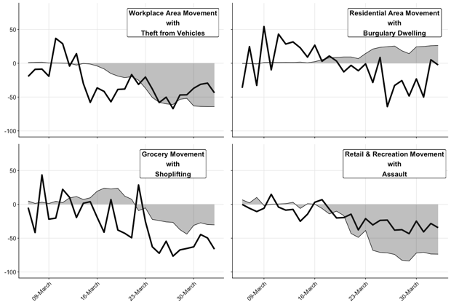Coronavirus and crime
New Preprint: “Coronavirus and crime: Social distancing, lockdown and the mobility elasticity of crime”

We have just published a new paper (DOI 10.31235/osf.io/4qzca) on the social sciences preprint archive SocArXiv. The paper examines the recent changes in crime rates that have come about as the UK entered lockdown in response to the COVID-19 pandemic. Some crimes increase or decrease following the change in mobility quite closely, others less so. The paper is available here: https://osf.io/preprints/socarxiv/4qzca/
Abstract
Governments around the world restricted movement of people, using social distancing and lockdowns, to help stem the global coronavirus (COVID-19) pandemic. We examine the effect of restricted mobility on crime for one UK police force area. One week after lockdown, all recorded crime had declined 41% with variation by type: shoplifting (-62%), theft (-52%), domestic abuse (-45%), theft from vehicle (-43%), assault (-36%), burglary dwelling (-25%) and burglary non-dwelling (-25%), compared to their expected rates. There were pre-lockdown spikes in shoplifting and assaults. We use area-specific Google Covid-19 Consumer Mobility Reports to calculate the mobility elasticity of crime for four crime types, finding shoplifting elastic to reduced grocery sector mobility (MEC > 2), burglary dwelling elastic to increases in residential area mobility (-1), with assault and theft from motor vehicle inelastic but still responsive to reduced movement under lockdown (0.48 and 0.69 respectively). We identify implications for theory, policy and future research.
Keywords
COVID-19 and crime; mobility and crime; Google COVID-19 consumer mobility reports; mobility elasticity of crime; crime decline; crime drop.
